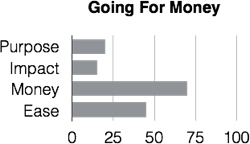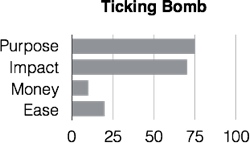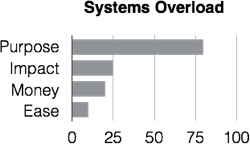Effective leadership produces a sustained result within the organization’s purpose. I developed the Positive Impact Scale to manage tradeoffs between Purpose, Impact, Money, and Ease. I wrote about those in 4 Tradeoffs to Create Positive Impact. This article looks at 4 strategies you may follow that actually reduce Positive Impact.

It’s sometimes more instructive to talk about what not to do. I’ve seen 4 common mistakes that leaders make when trying to create positive impact. By understanding these 4 mistakes, you can plan activities and predict outcomes, even unintentional ones, better.
Making Someone Else’s Impact – Feel-Good Impact
The good is the enemy of the best. That is the case with Feel-Good Impact. A classic example is the non-profit focused on the slow work of poverty alleviation through education. That is its Purpose. They face the constant temptation to do something with immediate Impact – orphans, child labor, human trafficking, food distribution, or any host of other good things.
 The Purpose of an organization is not arbitrary, it is paramount. Achieving Purpose is the ultimate measure of success. Activities that are not high on the Purpose scale distract us and use valuable resources that cannot be applied toward our Purpose.
The Purpose of an organization is not arbitrary, it is paramount. Achieving Purpose is the ultimate measure of success. Activities that are not high on the Purpose scale distract us and use valuable resources that cannot be applied toward our Purpose.
The Feel-Good Impact activities are some of the trickiest, because you can’t argue that they didn’t made an Impact. They did! However, an Impact not within your Purpose is someone else’s Impact to make. Someone committed to continue when it gets tough and when it doesn’t feel good any longer. Someone whose Purpose it is to make that Impact.
Know your Purpose. Stick to it for the long-term. Avoid Feel-Good Impact by making sure that each activity is solidly within your Purpose.
The Tail Wagging The Dog – Going For The Money
“It’s easy money,” this temptation says, “and we need to money in order to continue making an Impact.” Activities that produce Money but are not high in Purpose or Impact is the tail wagging the dog.
 Just because it pays well doesn’t mean you should be doing it. The clear priority of the non-profit organization is Purpose and Impact over profit. Saying that we’ll make Money over here to pay for Impact over there, is Going For The Money.
Just because it pays well doesn’t mean you should be doing it. The clear priority of the non-profit organization is Purpose and Impact over profit. Saying that we’ll make Money over here to pay for Impact over there, is Going For The Money.
While you are doing the Money making activity, you are not doing Purpose and Impact activities. If you do actually make Money – remember, many times it doesn’t work out how you imaged it would – it’s distracting your staff from your Purpose and all too tempting to do it again next time. Before you know it, you have two parallel organizations. One that generates Money and one that is driven by Purpose and Impact. And when the two conflict for resources, guess which one will get them? That’s right, the one that makes money.
Keep your activities and your organizational resources focused on your Purpose and Impact. Optimize these activities to reduce expenses and bring in Money. In this way, you generate Money as you make an Impact within your Purpose.
Blinded By Success – The Ticking Bomb
I’ve coached many non-profit leaders whose organizations achieved fantastic Impact within their Purpose. They shared the results and received applause and accolades for their work. Yet, every 6 months the organization was in a financial crisis. Some have even folded while achieving their best Impact. What happened?
 When Purpose and Impact are high, but Money and Ease are low, it’s like a ticking time bomb waiting to go off. Those activities, while spot on, are not sustainable. The Ease it takes to do them are very low, meaning it takes a lot of work and organizational resources. Meanwhile, either the costs are high or they do not generate much Money.
When Purpose and Impact are high, but Money and Ease are low, it’s like a ticking time bomb waiting to go off. Those activities, while spot on, are not sustainable. The Ease it takes to do them are very low, meaning it takes a lot of work and organizational resources. Meanwhile, either the costs are high or they do not generate much Money.
It’s too easy to be blinded by the success of our Purpose and Impact, and miss the more mundane dynamics that sustain them. If you want to deliver Impact for years to come, you must pay attention to Ease and Money.
Everyone For Themselves – Systems Overload
Non-profit organizations are founded with a Purpose in mind. Visionary leadership chases after Impact while attracting people to the organization who are often visionary themselves.
 In all this excitement, efficiency is not a top priority. “After all,” they say, “we’re here to make an impact, not build an organization.”
In all this excitement, efficiency is not a top priority. “After all,” they say, “we’re here to make an impact, not build an organization.”
Yet, clear expectations for staff and systems of how things are prioritized, decided, managed, and funded are essential. If these system (policies and procedures) are not in place, the organization will become bloated organizationally and cost more to run. After a while doing any activity becomes difficult. The visionary leader feels like a millstone is around his or her neck.
The way out is to give attention to policies and procedures. The more robust these systems are, the more energy and resources can be applied to Impact again and again.
Now It’s Your Turn
Think through your activities. Make a rough guess at where each activities falls on Purpose, Impact, Money, and Ease. What do you see?
Which have the highest Purpose? Lowest Purpose? Remember, Purpose is the foundation. Impact is the goal. And Money and Ease are resources to be used to achieve Impact.
Part 1 of this series is 4 Tradeoffs to Create Positive Impact. Part 3 is Coaching The Positive Impact Scales.
Question: What insights do you have that would improve your positive impact? You can leave a comment by clicking here.


Please note: I reserve the right to delete comments that are offensive or off-topic. You own your comments but give me permission to use them. See My Comments Policy. Read my Permissions Policy to know how you can use my posts.